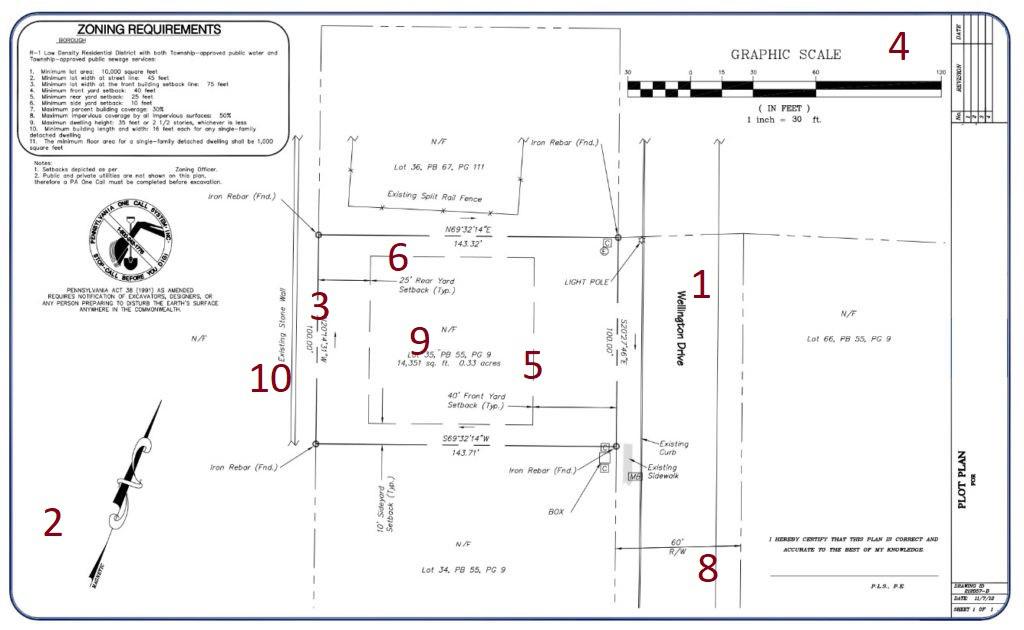Home > Blog
Read Time — 7 minutes
10 Key Things a Plot Plan Tells You

What is a plot plan?
Consider this: your customers have settled on the design of their new home, selected the property boundaries, colors and options, and you’re ready to begin construction. But have they signed off on the plot map? If you’re new to the home building industry, whether you’re a custom home builder or on-your-lot builder, it’s important to understand what a plot plan is and the important information you (and the homebuyer) will need to know about the lot.
What’s a plot plan, and why should I care?
Quite simply, a plot plan is just the “official term” for a map of your lot—showing where the house will be located on that lot. It is a required document when submitting for a building permit.
While it may seem like there are only so many places to put the house on the lot (especially in modern developments), the plot plan tells you a lot of important information.
- It ensures the house fits
- It lets you know what you can (or can’t) do in the future
- It helps ensure you’re on the right lot
- It points out other critical information
This article will show you a simple plot plan and describe the basics of what you will want to know, so you can confidently discuss it with your homebuyer.

1 - Street name(s) on the plot plan
One of the most obvious features of a plot plan is simply the street name on which the new home sits. If you happen to be looking at a plot plan that has a different street name than where you thought, you might want to speak up! An error like this is rarely made, but it’s still possible.
If your lot happens to be on a corner where two streets connect, you should be able to see both street names. Depending on the municipality and/or postal service, it may be possible to choose which street name becomes the official address (or which way the new home may face). You may want to discuss these options with the buyer.
2 - Direction the lot faces
See that big arrow in the lower-left corner of the plot plan image above? That's simply pointing out which way is north on the plot plan.
Why might this be important to you?
You may want the front of the house to have southern exposure, which is really nice in a cold climate and you want the sun to help melt the snow in the winter, or to prevent direct sunlight on the deck/patio in the later afternoon.
3 - Lot dimensions
If you look at the outside lines of the lot on the plot plan. You'll see the length and width of your lots shown in linear foot pretty quickly. This will let you know what size the lot is.
Keep the lot dimensions handy for future use if you are looking to get a quote on something like a fence that would run along with parts of your lot's perimeter in the future. It's nice to have that handy, so you don't get quoted for 120' of fencing when you only have 100' on your plan.
4 - Elevation/slopes; scaled dimensions
Every plot plan includes a scale for proper measurement. Just look for the scale, and you'll know how to make the conversion to measure. This allows you to ensure the house will fit on the lot, and it is important to know what else might fit (think swimming pool, etc.).
5 - Size/acreage of the lot
Typically, right in the center of the lot on the plot plan, you'll see the size of the lot. Often, you'll see both the square footage of the lot and the acreage.
Knowing your lot's size/acreage can be important if your local government has restrictions on how much of that lot can be used up with house, driveway, sidewalks, patios, pools, etc. Known as "impervious coverage," many local governments put a "cap" on what can be added to an individual lot.
6 - Building setbacks
There are restrictions on every lot that will limit where the house can be placed. These are known as building setbacks and are usually parallel to the property lines. Every municipality and/or location is specific, so the building setbacks will be shown on your individual plot plan and can't typically be changed. Building setbacks are established for several reasons:
- To establish a "standard" for where the fronts of houses are set, so there is uniformity among the homes. The front of the house is known as front yard setbacks.
- Rear yard setbacks, on the other hand, show how far off the rear property line that the house (or other structures/pools/etc.) must be. Again, this is to make sure there is room between structures and the neighbors.
- The building setbacks to each side of the house are known as side yard setbacks. Depending on the lot, these can also change from zero (think either side-by-side townhouses or duplexes that straddle a property line) to a number set by the local government.
7 - Driveway location and size
Once the house is drawn on the plot plan, the driveway's location and size are also shown. The driveway size is calculated in that impervious coverage. While the driveway may look good and fit on the plot plan, it may not be practical in reality. The homebuyer could end doing a three-point turn to get into the garage, or if it’s too close to an intersection, that increases the likelihood of an accident. These situations can result in inconveniencing the homeowner and/or impacting resale based on an unusual layout.
8 - Easements and rights-of-way
Almost every lot has areas called easements and rights-of-way. These two areas on the lot may allow others to legally enter and/or do work on the property and/or may limit your ability to build or add things to your lot. While that may seem discomforting and/or illegal, these areas allow utility companies and municipalities to do necessary additional work around the property.
9 - Lot number, parcel (tax ID) number
Typically, in the middle of the plot plan, two important numbers will be listed – both of which will most likely be needed for your building permit application (and important for you to double-check to ensure they are accurate).
- The lot number - Residential developers number their lots as they create the development.
- The parcel (or tax ID) number - The parcel number is set by the local governing body and used for property taxes in the future.
10 - Encroachments
Encroachments are things that might end up on your lot but aren't yours (and shouldn't be on your lot).
An example of an existing stone wall is shown on the picture. While it doesn't encroach on this lot, the plot plan shows that it exists. If an encroachment does exist, it may require a conversation with the encroaching neighbor.
Bottom line
Knowing these 10 things about your plot plan will go a long way to give your buyers an understanding of their future home site and what can (and can't) be done.
Automating the process
MarkSystems is a cutting-edge software solution designed to simplify and streamline the management of plot plans. Effortlessly visualize and analyze plot plans, ensuring a smooth and accurate planning process.



